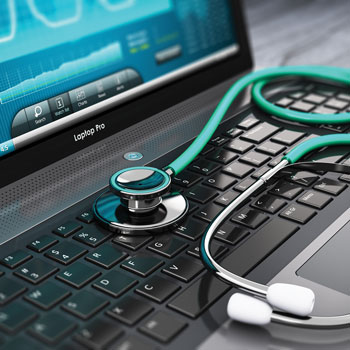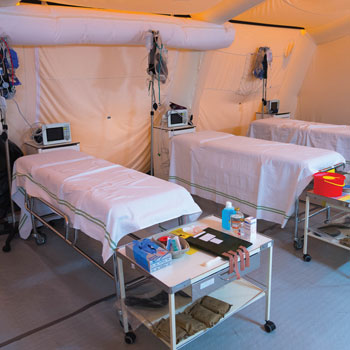For med students, when does follow-up cross the line?
Medical students are using electronic health records to virtually follow up on patients' outcomes. While it's meant as a way of improving care and learning, it can be interpreted as a violation of patient privacy.
Electronic health records (EHRs) have allowed health care professionals unprecedented access to the breadth and depth of patients' medical histories. But with all of this information at their fingertips, medical students need guidance on the appropriate use of EHRs to follow up on patients.
A study published in September 2016 in JAMA Internal Medicine found that many students track former patients after they have left their direct care. Gregory E. Brisson, MD, assistant professor of clinical medicine at Northwestern University Feinberg School of Medicine in Chicago, and colleagues surveyed 103 fourth-year medical students in August 2013, asking seven questions about tracking patients with EHRs and whether doing so raised ethical concerns. Survey participation was voluntary and anonymous.
“We found that nearly all students at our institution who responded to our survey followed up on former patients in the EHRs,” Dr. Brisson said. “I suspect that this would be similar at other institutions.”

The respondents cited several reasons for using EHRs to track former patients, most commonly to follow up on pending studies or confirm a diagnosis, or to follow up on a patient's progress during treatment. However, 40% of respondents said they accessed EHRs to track a patient because they “liked the patient” and were “curious to see how he or she was doing.” Of the students who admitted using EHRs to track former patients, only 17.2% had ethical concerns about it.
“I would not say this practice is inherently good or bad, but rather that it depends on why and how it is being done,” said Michael Green, MD, MS, FACP, professor in the departments of humanities and medicine at Penn State College of Medicine in Hershey, Pa.
In fact, the Health Insurance Portability and Accountability Act of 1996 (HIPAA) does not prohibit medical students or trainees from accessing patient medical information during the course of their training. Under its Privacy Rule, it provides for “conducting training programs in which students, trainees, or practitioners in areas of health care learn under supervision to practice and improve their skills as health care providers.”
However, “motivation matters,” Dr. Green said. “Why somebody does something changes the meaning of that action.”
Education vs. privacy
According to Mark T. Hughes, MD, MA, FACP, assistant professor of medicine in the division of general internal medicine at the Johns Hopkins University School of Medicine in Baltimore, medical students have always done a certain amount of patient follow-up. In the era of paper-based charts, though, it was much more difficult, he noted.
“It was encouraged for students to find out what happened to patients, but that was usually through word of mouth,” said Dr. Hughes, who also co-chairs the Johns Hopkins Hospital ethics service. Patients who come to a teaching hospital have some expectation that they are helping in the training of future physicians and grant access to those students during their clinical care.
“Tracking patients through EHRs provides a lot of potential for learning,” Dr. Hughes said. “It helps to clarify the differential diagnosis that a student formulated but was never able to know what happened.”
The ethics of the situation largely hinge upon respect for patient autonomy, Dr. Hughes said.
Dr. Green added that the simplest way to address ethical concerns raised by this practice is to seek patients' permission and document their response in the medical record.
“It may be as simple as asking, ‘After you leave, is it OK if I check on your labs or records to see how things are going and find out what happened?’” Dr. Green said. “It is about informed consent. If a patient gives permission to access their file, then it is not a HIPAA violation.”
Dr. Brisson added that at Northwestern, documentation is not required because it is a technical challenge. “Also, we trust properly trained students to examine patients independently, so we can trust properly trained students to examine the medical records of patients.”
Training students
Many of the ethical and legal questions around the practice of tracking patients with EHRs are yet to be formally explored. However, Carrie Horwitch, MD, MPH, FACP, Chair of ACP's Ethics, Professionalism and Human Rights Committee, pointed out that accessing a patient's record when there is no longer a patient/physician relationship can be problematic.
“Most medical students, and even residents, may not be aware that when using EHRs, every entry into a patient's chart is documented and time stamped,” Dr. Horwitch said. “I would recommend that medical schools and residency programs have some guidance around the appropriateness of this practice and provide messaging on how to do this that would not violate ethical or HIPAA requirements.”
Dr. Hughes added, “In the ready-access era of EHRs, most contemporary students are used to having information at their fingertips. It is easy to check on people from afar, and not just in medicine, and that poses new challenges for this generation.”
Dr. Brisson said that since conducting the survey, one of the challenges he has faced is helping students to understand the potential for harm that could result from tracking patients with EHRs.
“When a medical student accesses an EHR on a patient, the student can see everything that has happened in that patient's life leading up to that admission, and the patient understands that,” Dr. Brisson said. “When tracking is occurring, students can also access future health records about that patient, including things that may not be related to their educational objective, and the patient may not be aware of that or may not want the student to know certain things.”
For example, a patient may come into the hospital to be treated for pneumonia and may be sent for an outpatient follow-up chest X-ray 4 weeks later. The medical student on the case may be wondering how that patient is doing and whether the pneumonia resolved, or if it was related to a complicating factor, such as a lung mass, Dr. Brisson said. Tracking enables the student to get a more complete picture of the patient's problem.
“But let's say that during that interval the patient contracted a sexually transmitted infection and when the student accesses the medical record they stumble upon that additional private information that the patient may not want them to know about,” Dr. Brisson said. “By accessing the future record, they are accessing private information.”
Dr. Brisson and colleagues are currently developing guidelines that seek to explore the use of EHRs for educational purposes without violating patient privacy. The guidelines include two key elements: making patients aware that students may be accessing their EHRs after discharge, and educating students about tracking former patients in an ethically appropriate manner.
“It is a privilege to be able to follow up on patients in the EHR, and students have a duty to use that privilege properly,” he said. “They should limit tracking to those aspects of the chart that relate to their educational follow-up, and that follow-up should be limited to only that problem you saw the patient for.”
Much of what will be included in the guidelines will simply reinforce the principles of ethics and professionalism that students are already being taught, according to Dr. Brisson. These include providing patient-centered care and maintaining autonomy, privacy, and confidentiality, but extending them into the digital realm.
“It is a new way to think about principles that are at the foundation of the doctor-patient relationship,” he said.





